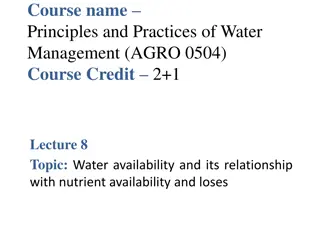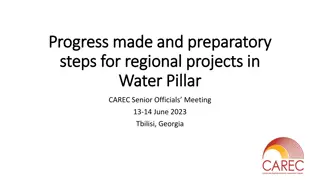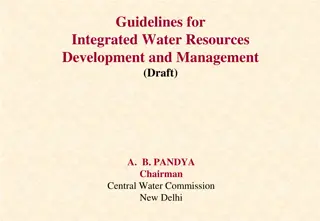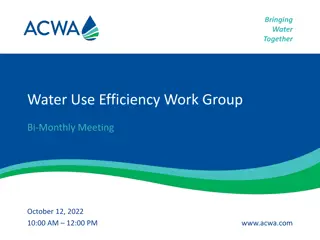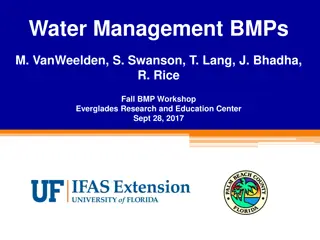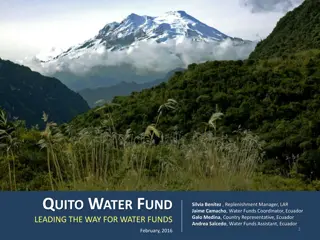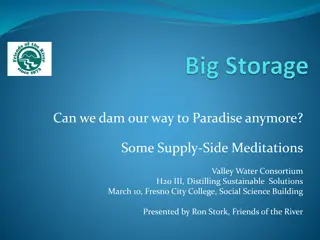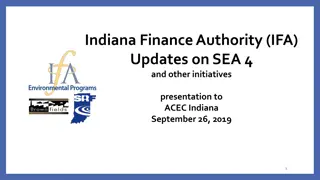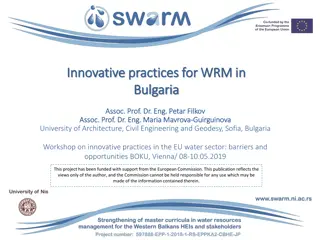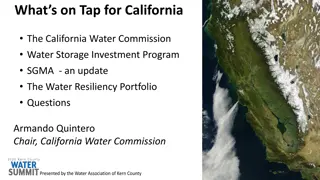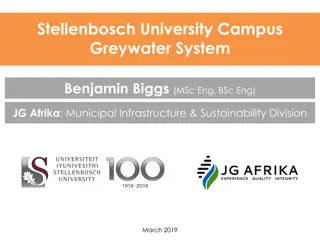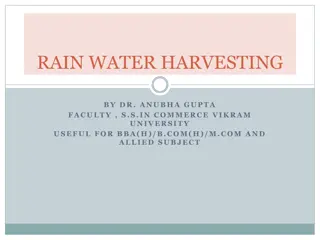Strategies for Sustainable Water Management
Drivers for indirect potable reuse include water stress, population growth, industrial development, droughts, and climate change. Other drivers for water reuse encompass conservation, environmental enhancement, pollution abatement, and regulatory policies. Rising water rates and costs of imported water highlight the urgency for conservation and implementing non-potable reuse solutions like agricultural irrigation and wastewater treatment to address water scarcity. Long-term strategies may involve direct potable reuse for sustainable water management.
Download Presentation

Please find below an Image/Link to download the presentation.
The content on the website is provided AS IS for your information and personal use only. It may not be sold, licensed, or shared on other websites without obtaining consent from the author.If you encounter any issues during the download, it is possible that the publisher has removed the file from their server.
You are allowed to download the files provided on this website for personal or commercial use, subject to the condition that they are used lawfully. All files are the property of their respective owners.
The content on the website is provided AS IS for your information and personal use only. It may not be sold, licensed, or shared on other websites without obtaining consent from the author.
E N D
Presentation Transcript
Drivers for Indirect Potable Reuse
Drivers for Reuse Principal driver is water stress (need for water) Scarcity of renewable freshwater resources due to: Population increases Industrial development Droughts Global climate changes
Drivers for Reuse Other drivers include: Conservation of potable supply Environmental enhancement Pollution abatement Reliability of supply High cost of alternative sources of water Regulatory policies/regulations
MWD Water Rates Rise When Sales Fall 900.00 Water Rate (S/AF) 19.7% Increase 800.00 700.00 75% Increase 600.00 85% Increase 500.00 400.00 89%Increase 300.00 200.00 35 30 100.00 25 20 - Gas 15 Motel 10 1978 1980 1982 1984 1988 1990 1992 1996 1998 2000 2002 2004 2006 2008 2010 2012 1986 1994 5 0 Jan Feb Mar Apr May Jun
Cost of Imported Water to San Diego - Nearly Double by 2018 Projected Cost of Imported Treated Water per Acre-Foot $2,000.00 $1,800.00 $1,757 $1,600.00 Cost per Acre-Foot in Dollars $1,660 $1,587 $1,400.00 $1,516 $1,416 $1,200.00 $1,329 $1,185 $1,000.00 $1,063 $800.00 $905 $600.00 $400.00 $200.00 $0.00 2010 2011 2012 2013 2014 2015 2016 2017 2018 Fiscal Year Cost of Imported Water per Acre-Foot Source: San Diego County Water Authority
Short/Intermediate Term Response is Non-potable Reuse Agricultural irrigation Landscape irrigation Industrial uses Other nonpotable uses Wastewater Treatment
Short/Intermediate Response is Indirect Potable Reuse Surface water or Groundwater* Water Treatment Wastewater Treatment *Extracted Groundwater may not receive further treatment
Long Term Response is Direct Potable Reuse Definitions Water Treatment Surface Water or Groundwater Wastewater Treatment
Predictions ( the next 25 years)
#1 Technology Advances will decrease $ and eventually allow direct potable reuse Reverse osmosis (RO) to be replaced by NanoElectrolyticOsmosis (NEO) Genetic engineering will develop high-rate digestion bacteria that will more efficiently convert biosolids to fuel Real-time monitoring of all water quality constituents will be developed and approved by regulatory agencies
#2 Full integration of resource management into reuse planning Interim Step is from Bolt-On Approach Microfiltration (MF) Reverse Osmosis (RO) Ultraviolet Light with H2O2 Barrier Backwash OCSD Plant 1 Brine OCSD Outfall To Liquid Process Integration Pretreat MBR RO/UV
#3 Full integration of resource management into reuse planning Total Urban Resource Recovery Systems Sewage Primary Revenue Sources: Water & Energy Primary Clarification or Filtration Low Energy Membrane for BOD and TDS removal Urban food waste Septage Misc. organics Electricity Methane Efficient Electricity Generation Optimized Anaerobic Digester Nutrient Removal and Recovery CO2 Secondary Revenue Sources: Biofuel, Fertilizer & Carbon Credits Algae Conversion to Biodiesel Final Filter Biodiesel Inorganic Fertilizer
#4 The nexus between water and energy and the public response to climate change will impact how we view the cost of water We will be billed not by the units of water we used, but by the carbon footprint that is created by developing the water supply For example, groundwater will have low carbon foot print while desalination will be high
#5 The pace of reuse development will be relatively slow unless .. You never let a serious crisis go to waste. And what I mean by that it's an opportunity to do things you think you could not do before . Rahm Emmanual Crisis is Opportunity
Past Lessons are Present Lessons are Future Lessons LEADERSHIP VISION Keys to Keys to Reuse Success Reuse Success POLITICAL WILL PARTNERSHIP GRANTSMEN- SHIP INNOVATION
History of Advocacy (the last 25 years)
Advocacy Groups can Address Non- Technical Barriers to Indirect Potable Water Reuse Public/user perception and cultural issues Toilet to Tap Syndrome Better documentation of economics of water reuse Support by local authorities/policy makers Project funding
New Players Advocating for Reuse 1984 Protect Oceans Surfriders 1985 Heal the Bay Stop discharge into Bay 1990 WateReuse Association Promote reuse
New Players Advocating for Reuse 1991 Promote Water Supply NWRI 1992 Bureau of Reclamation Fund Reuse (Title XVI) 1999 Coastkeeper Alliance Promote healthy coast
San Diego IPR Coalition (broad based advocacy) Insert graphic with IPR Coalition logos and tell the story





